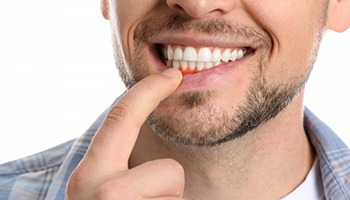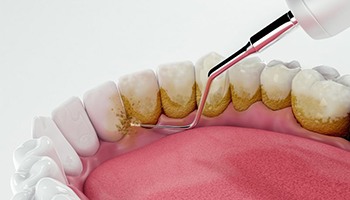
Gum Disease Treatment – Barnegat, NJ
Therapy for Your Infected Gums
Remember, teeth aren’t the only parts of your mouth to look after. The pink tissue around them is just as crucial to oral health. If you don’t look after it, you could easily suffer from gum disease. Still, the latter issue isn’t unsolvable. Just visit our office for gum disease treatment! At Nu Dental of Barnegat, this therapy eases your infection and helps your gums heal. To learn more about it, continue reading or book a consultation today.
Why Choose Us for Gum Disease Treatment?
- We Utilize Laser Dentistry
- A Highly-Trained Dental Team
- Evening/Saturday Appointments
What is Gum Disease?

Put simply, gum disease is an infection that damages the tissue around teeth. It’s usually caused by plaque buildup, often due to bad oral hygiene. However, other possible causes include genetics, medications, and hormonal changes.
Overall, there are two main types of gum disease. The first is gingivitis, the ailment’s earliest stage that causes inflammation. Meanwhile, the second form is periodontitis – an advanced infection that destroys gum and jaw tissue. While gingivitis can be reversed by improved oral care, periodontitis can only be managed to prevent worse effects.
Symptoms of Gum Disease

Overall, the symptoms of gum disease can vary. Which you show will depend on your infection’s severity.
Common signs of gingivitis include:
- Chronic bad breath
- Red or swollen gums
- Bleeding gums
- Gum tenderness
- Dark red gums
- Gum recession
In contrast, the typical signs of periodontitis are:
- Chewing pain
- Loose permanent teeth
- Tooth sensitivity (often as a result of gum recession)
- A shift in your bite
- Changes in your restoration’s fit
- Permanent tooth loss
How Do We Treat Gum Disease?

Before treatment, our dentists will perform an oral exam. This step lets them confirm the exact state of your gums. From there, they’ll review their findings and discuss your potential treatment options.
At Nu Dental of Barnegat, these options are the following:
Scaling & Root Planing

Scaling and root planing is a deep cleaning below the patient’s gumline—a method that generally goes further than normal professional teeth cleaning. The procedure is meant to remove tartar, plaque, and bacteria that inflame your gum tissue. After the first portion of the process, our team will smooth out your tooth roots to prevent future accumulation of bacteria as well as allow your gum tissue to attach more easily and heal more effectively.
Do You Need Scaling & Root Planing?

Otherwise known as a “deep cleaning,” our dental team will typically recommend this procedure if we notice any indications of gum disease early on. These symptoms can include bleeding, inflammation, and swelling in the gum line, which we’ll need to address right away to keep the infection from spreading or worsening. This treatment is designed to remove bacteria and plaque that’s settled around and underneath your gum line. Not only will this process help lower the risk of negatively impacting the rest of your oral health, but it can also improve your periodontal tissue by making it easier to recover and reattach to your pearly whites.
The Process of Scaling & Root Planing

Generally, scaling and root planing are done over two dental visits. During the first stage, your dentist will clean off any plaque and tartar from your gum line, which is known as scaling. We will use specialized dental tools to effectively do this while making sure you’re as comfortable as possible. With these instruments, we’ll also be able to address the areas below your gum line, ensuring a thorough cleaning of your mouth.
After eliminating plaque and bacteria, our team will then smooth out your tooth roots, which is the root planing portion. Doing so ensures your gums are healthily reattached to tooth structures while also making it more difficult for future bacteria to accumulate in the area. This can significantly increase your chances of avoiding the development of periodontal disease in the long run.
Aftercare Tips for Scaling & Root Planing

It’s quite normal for patients to feel sore or tender in the gums after scaling and root planing. You might even expect some swelling after the process, but this should only be a temporary thing. In most cases, your mouth should return to normal within a few weeks. In the meantime, here are several tips you can implement to ensure a smoother recovery:
- Rinse your mouth with salt water after meals to wash out food particles and avoid irritation
- Carefully brush twice daily with a soft-bristled toothbrush and toothpaste containing fluoride
- Floss gently and thoroughly once a day or after eating
- Keep away from hot, acidic, or spicy foods
- Stick to a soft-food diet for at least the first 48 hours after your procedure
- Avoid excessive physical activity right after your appointment
Antibiotic Treatment

With antibiotics, dentists can target and eliminate the microbes that cause gum disease. So, a practice may offer one to treat your gums. How the antibiotic works will depend on which kind you get.
At our office, we happen to use Arestin microspheres. These spread Minocycline into your gum pockets to treat infected areas. The medicine is released over two weeks, so you won’t need to take a pill or regularly use a mouth rinse.
Osseous Surgery

As a treatment, osseous surgery is unique. It reduces the pockets around your teeth, thus keeping plaque and bacteria from hiding in them.
There are two kinds of osseous surgery. The traditional one makes incisions to reach your tooth roots. (That way, it can reshape the bone around teeth to remove deep pockets.) In contrast, the newer method uses a laser to kill bacteria while keeping healthy tissue safe.